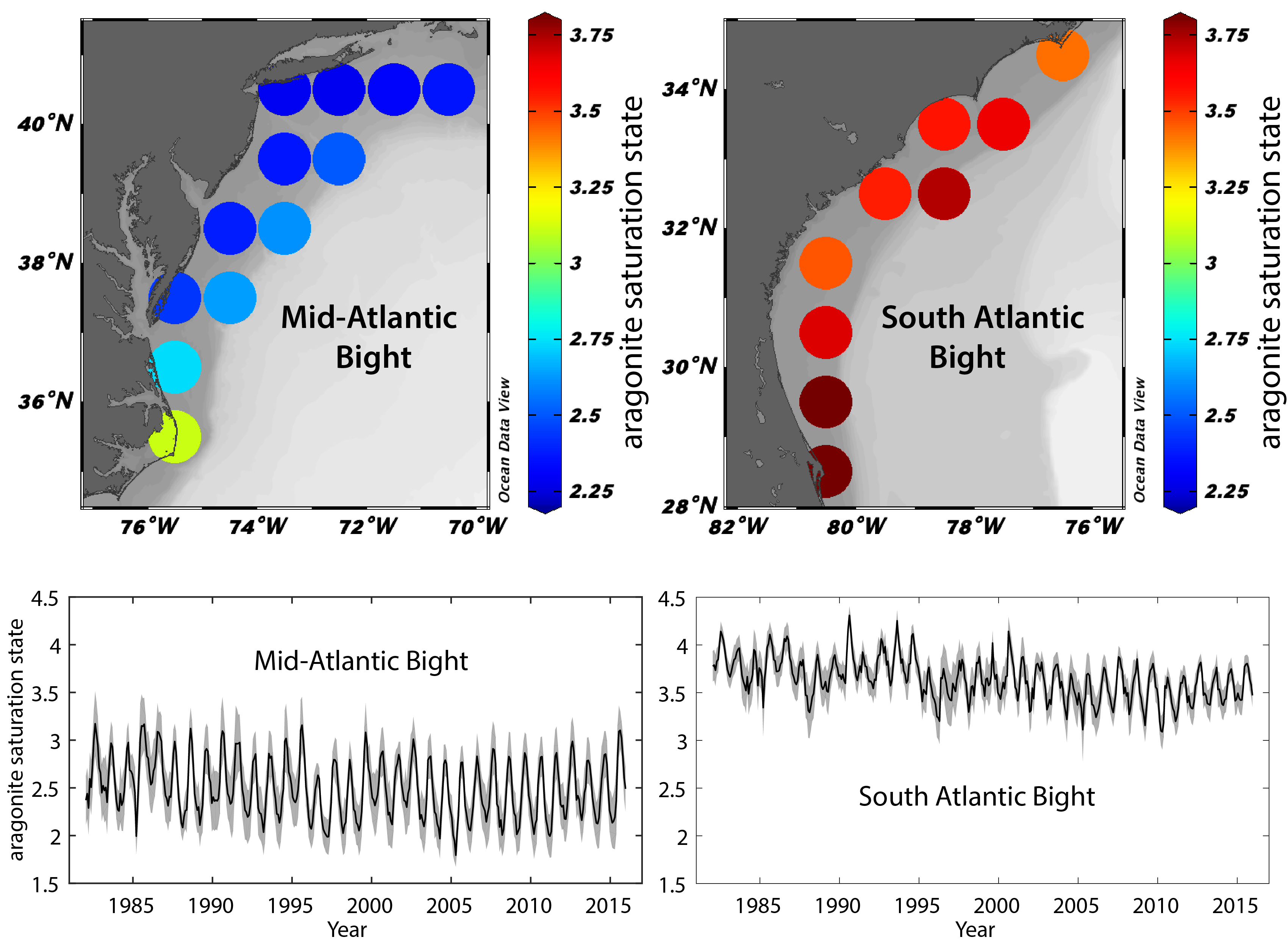NDP-102 (2020)
NCEI Accession 0208346 Data and Documentation Files
Monthly gridded sea surface fugacity of carbon dioxide (fCO2), total alkalinity (TA), dissolved inorganic carbon (DIC), pH, and aragonite (Ωarag) in Mid-Atlantic Bight and South Atlantic Bight from 1982 to 2015 (NCEI Accession 0208346)
Yuan-Yuan Xu1, Wei-Jun Cai2, Rik Wanninkhof3, Joseph E. Salisbury4
Prepared by Alex Kozyr5
1University of Miami, Cooperate Institute for Marine and Atmospheric Studies, Miami, FL, USA
2University of Delaware, 111 Robinson Hall, Newark, DE, 19716, USA
3Atlantic Oceanographic and Meteorological Laboratory (AOML), 4301 Rickenbacker Causeway, Miami, FL, 33149, USA
4University of New Hampshire (UNH), Durham, NH, 03824, USA
5National Centers for Environmental Information, National Oceanic and Atmospheric Administration, 1315 East-West Highway, Silver Spring, MD 20910-3282, USA

Abstract
Monthly interpolated sea surface fCO2 from 1982 through 2015 is estimated from monthly atmospheric CO2, temperature, and salinity. Firstly, the disequilibrium between the observed seawater fCO2 and fCO2air (i.e., ΔfCO2; ΔfCO2 = fCO2 – fCO2air) is estimated using a Bayesian-neural-network approach for each 1°×1° grid box in the MAB and the SAB. The input parameters are latitude, longitude, SST, and SSS. The output parameter is ΔfCO2. The feedforward backpropagation network is constructed by two hidden layers with tanh activation functions. The neural network is trained with the Levenberg-Marquardt algorithm (Hagan and Menhaj, 1994). Then fCO2 is calculated using ΔfCO2 and fCO2air. Next, continuous monthly SST and SSS data from 1982 to 2015 are used to calculate output with the trained network to fill in SOCAT data gaps. Monthly pH, DIC, and Ωarag are calculated from fCO2 and salinity-derived TA using CO2SYS (Van Heuven et al., 2009) with the first and second dissociation constants of carbonic acid in seawater (K1 and K2) from Lueker et al. (2000) and borate-to-salinity ratio determined by Uppström (1974). TA is derived from salinity using their linear relationships in the MAB and the SAB (Cai et al., 2010).
Method citation:
Xu, Y.-Y, Cai, W.-J., Wanninkhof, R., Salisbury, J., Reimer, J., and Chen, B. (2019). Long-term changes of carbonate chemistry variables along the North American east coast. Journal of Geophysical Research: Oceans. In Review.
Variables:
- lon: longitude in degrees east (70.5°W – 80.5°W with 1° resolution)
- lat: Latitude in degrees north (28.5°N – 40.5°N with 1° resolution)
- time: Time in seconds since 2000-01-01-00:00:00 (monthly resolution)
- sst (lon, lat, time): Sea surface temperature, OISST version 2 data obtained from NOAA’s ESRL Physical Science Division at https://www.esrl.noaa.gov/psd/data/gridded/data.noaa.oisst.v2.html.
- sss (lon, lat, time): Sea surface salinity, EN4 temperature and salinity data were obtained from Met Office Hadley Center at https://www.metoffice.gov.uk/hadobs/en4/download-en4-2-1.html.
- fco2sw (lon, lat, time): Sea water fugacity of carbon dioxide. Unit: µatm.
- alkalinity (lon, lat, time): Total alkalinity. Unit: µmol kg-1.
- ph (lon, lat, time): In situ pH on total scale.
- dic (lon, lat, time): Dissolved inorganic carbon. Unit: µmol kg-1.
- aragonite (lon, lat, time): Seawater aragonite saturation state.
Xu, Yuan-Yuan; Cai, Wei-Jun; Wanninkhof, Rik; Salisbury, Joseph E. (2020). Monthly gridded sea surface fugacity of carbon dioxide (fCO2), total alkalinity (TA), dissolved inorganic carbon (DIC), pH, and aragonite (Ωarag) in Mid-Atlantic Bight and South Atlantic Bight from 1982 to 2015 (NCEI Accession 0208346). [indicate subset used]. NOAA National Centers for Environmental Information. Dataset. https://doi.org/10.25921/bzne-9615. Accessed [date].
References::
- Cai, W. J. et al. (2010). Alkalinity distribution in the western North Atlantic Ocean margins. Journal of Geophysical Research-Oceans, 115.
- Hagan, M. T. and Menhaj, M. (1994). Training feedforward networks with the Marquardt algorithm. IEEE Transactions on Neural Network, 5(6), 989-993, doi:10.1109/72.329697.
- Lueker, T. J., Dickson, A. G. and Keeling, C. D. (2000). Ocean pCO2 calculated from dissolved inorganic carbon, alkalinity, and equations for K1 and K2: validation based on laboratory measurements of CO2 in gas and seawater at equilibrium. Marine Chemistry, 70(1-3), 105-119, doi:10.1016/S0304-4203(00)00022-0.
- Uppström, L. R. (1974). The boron/chlorinity ratio of deep-sea water from the Pacific Ocean. Deep Sea Research and Oceanographic Abstracts, 21(2), 161-162, doi:10.1016/0011-7471(74)90074-6.
- Van Heuven, S., Pierrot, D., Rae, J. W. B. and Wallace, D. W. R., 2009. MATLAB program developed for CO2 system calculations, Carbon Dioxide Information Analysis Center, Oak Ridge National Laboratory, U.S. Department of Energy, Oak Ridge, Tennessee.
